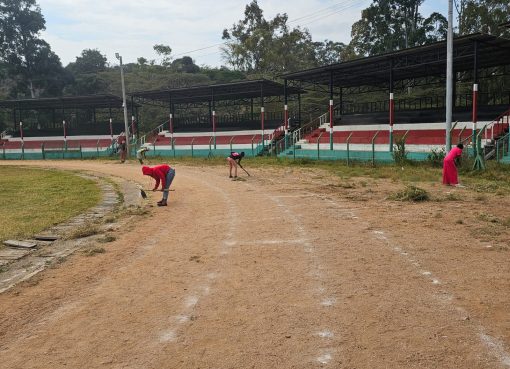With the growth of digital communication and information technologies that have made news and its consumption instantaneous, what is the future of traditional media houses? What is the future of journalism?
Which methods are most effective in countering disinformation and fake news in the modern information environment propped up by digital transformation? In the fast-evolving digital era, alongside its new tools, what is the role of traditional media in communication?
What is the future of news and views? These are tough questions that participants at the Shusha Global Media Forum in Azerbaijan tackled during the event that brought together over 200 guests from across the globe, including media owners and practitioners, government officials, state and business actors, media freedom advocates, and social scientists.

While inaugurating the three-day event, President IIham Aliyev of Azerbaijan told the participants that the massive growth of digital communication, also known as ‘New Media’ has pushed the traditional media houses into a phase of existential crisis.
President Aliyev, however, maintained that as much as the media landscape is rapidly evolving, there will always be a need for good journalistic practices that abide by a code of practice and conduct that provides for truthfulness, accuracy, objectivity, impartiality, fairness, and public accountability.
He observed that though citizen journalism on digital platforms sometimes results in inaccurate or biased reporting due to a lack of professional training and editorial oversight, it provides a platform for marginalised voices, enabling citizens to share their stories, advocate for social justice, and hold those in power accountable.
President Aliyev defined citizen journalism as an emerging genre of journalism in which content is user-generated, user-unedited, uncensored, and comes in real-time.
“Citizen journalism is a practice whereby people, without any form of training in journalism, take advantage of modern technological communication tools to collect and report breaking news accompanied by live pictures and images to a hungry audience faster than the traditional or mainstream media. It is also known as public, participatory, or democratic journalism; guerilla journalism; and street journalism,” he elaborated.
While noting that verifying sources and ensuring ethical reporting standards are crucial to maintaining the integrity of citizen journalism, President Aliyev indicated that the ‘New Media’ has played a pivotal role in shedding light on underreported issues.
“The dynamics of citizen journalism notwithstanding, the practice comes with its dangers and challenges. Some of these include cases arising from disinformation, misinformation, malinformation, and fake news. People know that traditional journalism follows a particular protocol or set of rules before publishing something. For this reason, it is easier to believe in it than citizen journalism,” the president explained.
He observed that digital media has created a borderless world where it takes minutes for bad news to spread across a vast population, where in the past, it would have taken hours or days. This, the president added, has increased pressure on corporations and governments to respond to issues in real-time across multiple platforms.
“Before the emergence of citizen journalism, we had the whole day to respond to an issue. If something happened in the morning, we would send a press release in the afternoon so that it could be carried in the evening news bulletins and the next day’s newspapers.
Today, we have a whole new constituency to address on Facebook, Twitter, and blogs, in addition to traditional media. This has put new pressure on corporations and governments because they must have a team ready to respond on behalf of our clients on a minute-by-minute basis,” he stated.
At the conference themed ‘New Media in the Era of the 4th Industrial Revolution, some of the challenges identified as facing the industry due to digitization included loss of revenue, loss of jobs for media practitioners, inability to catch up their operational models with current market demands, poor training and capacity, and weak financial positions.
The Chief Executive Officer of Azad Azerbaijan TV and Radio Company, Mr. Azer Khalilov, said the digital revolution is the source of profound change for journalism and could dramatically reshape everything known about journalism and the media.
Mr. Khalilov indicated that media houses must adapt to the digital revolution or risk perishing.
Additionally, he added that the emergence of social media channels as news sources has affected the flow of revenue in terms of advertising.
Other challenges Mr. Khalilov pointed out include training standards where the media training curriculum has not changed, thus hampering the quality and agility of media workers in an ever-changing digital media environment.
“Given the digital transformation, the media must find new ways of doing business, including introducing converged newsrooms, using digital business models, and retooling media workers,” the CEO advised.
International news presenter and journalist Ms. Maria Ramos, who moderated the first session, pointed out that although New Media has become the most convenient and prevalent communication channel with the ability to reach a broader audience, traditional media, which is no longer as dominant as it once was, is still a relevant source of information for a wide audience that is looking for the credibility and reliability of the news that is circulated on social media.
According to Ms. Ramos, despite the fact that traditional media and social media both have their pros and cons, the relationship between them is one of integration, not exclusion or cancellation.
Thus, the journalist and news anchor for 24-hour news channel TRT World in Istanbul, Turkey, opined that instead of being pitted against one another, traditional and new media should go hand-in-hand through successful integration, a complementary relationship, and sustainable sharing processes in a collaborative, cohesive, and ethical manner.
Ms. Ramos indicated that such integration would enhance their roles and services, provide added value, and enable them to reach the widest audience.
Canadian-American journalist, TV, documentary, podcast, and debate producer Ms. Dana Wolfe observed that the use of online platforms such as ‘Zoom’ to broadcast interviews and receive information from interviewees has protected mainstream news outlets from being discarded as the reports have been able to maintain a sense of professionalism.
Ms. Wolfe pointed out that the dynamics of citizen journalism notwithstanding, the practice comes with its dangers and challenges. Some of these include cases arising from disinformation, misinformation, malinformation, and fake news.
“In today’s fast-paced digital age, journalism is facing an unprecedented challenge. The proliferation of fake news and disinformation has led to a crisis of trust in the media,” she added.
Co-founder and Director of Forward Thinking, Mr. Oliver McTernan, noted that while the traditional voice of journalism is one that is grounded on truth, transparency, and accountability, the rise of fake news has made it increasingly difficult for journalists to do their job.
He said that fake news is designed to look like real news, but it is often sensationalised, exaggerated, or outright false.
Mr. McTernan stated that the impact of fake news is profound and that the problem is particularly acute on social media, where fake news spreads rapidly and is often difficult to distinguish from real news.
“This creates a challenging environment for new journalists who are trying to establish themselves in an already crowded and competitive field,” he observed.
Professor Paolo Von Schirach, who teaches Political Science and International Relations at Bay Atlantic University in Washington, D.C., said traditional media must learn to navigate the complex landscape of digital media, including social media platforms, blogs, podcasts, and video channels.
Professor Schirach, who is also the President of the Global Policy Institute, advised that traditional media owners should develop the skills necessary to produce engaging and informative content that resonates with a younger audience while maintaining the highest standards of journalistic integrity, rigorously fact-checking their sources, and avoiding sensationalism and bias.
“One big problem with citizen journalism is that it is difficult for people to decide what to believe, unlike traditional journalism, where it is safe to assume the information disseminated is factual. This means that citizen media should be checked and re-checked for accuracy to produce news that is suitable to print,” added the Don.
The participants nevertheless indicated that newspapers, radio, and television are still dominating the information world because they still have their purpose.
It was argued that there is something about the newspaper, radio, and television industries that makes them much more interesting than other delivery forms.
The forum underscored the importance of a multi-pronged approach by all stakeholders in the media industry, including state and non-state actors, to support efforts to combat fake news and disinformation.
This means providing the public with tools and resources to identify fake news and holding social media platforms accountable for the content they host.
It also means supporting the work of fact-checkers, who play a critical role in exposing fake news and holding those who spread it accountable.
By Anne Mwale and Anne Cheruiyot





